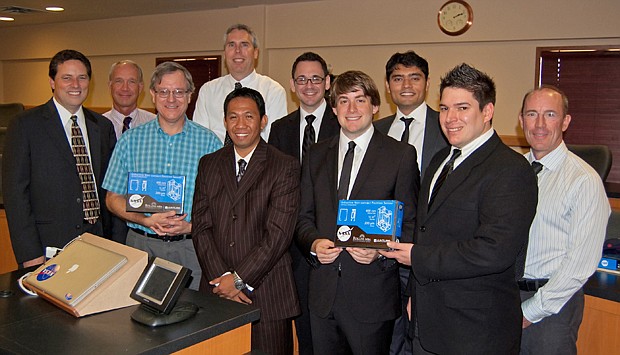- July 26, 2024
-
-
Loading

Loading

Skirting the surface of the thick glass windshield of a space shuttle, a non-contact induction sensor is in search of nicks and cracks on the smooth, tinted area.
At work, the inductor measures the exact size and scale of a crack down to one-fifth the thickness of a human hair, but the NASA-patented sensor technology itself totals the size of a tabletop.
In December, a group of four Rollins College MBA students presented to NASA a black and blue lunch-box-sized cardboard box with the same measuring sensor shrunk down to postage-stamp size and packaged inside. It’s the same technology, only smaller, better-packaged and more commercialized, student Jason Goldberg said.
Instead of only detecting space shuttle cracks, this version, he said, has the potential to increase the precision of 3D printing, help with miniscule measurements in Department of Defense projects, and – with some fine tuning – possibly help surgeons in the operating room make highly precise incisions.
“We were given a few months to provide a marketing plan to find out if there was any commercial viability for using the sensor outside of the shuttle program, which is what it was originally developed for,” Goldberg said. “And what we did was beyond putting together a marketing plan, what we decided to do was prototype and package the sensor technology.”
A Space Act Agreement signed last fall between NASA and Rollins gave Goldberg, two of his classmates and two professors the opportunity to take their choice from patent-pending NASA-developed technologies to try to commercialize and develop, tasked with finding a use and demand for it in other markets.
To learn more about the technology and techniques used by Rollins students to market NASA’s sensor patent, and their continued efforts outside the classroom, visit JunturaSensors.com
For more information about the Rollins Entrepreneurial Scholar of Distinction Program, visit tinyurl.com/RollinsESD
Rollins professor Peter McAlindon chose the non-contact inductive sensor and let his students take the lead, spending the semester taking the technology from large and overbearing to small and compact.
“If you can’t take something in a patent that NASA developed for a very specific program or application and reduce it what someone else can understand, you’re going to have a hard time selling it … the students did a great job at that,” McAlindon said.
Jim Nichols, who manages licensing for NASA, said they sought out the partnership with Rollins because of its nearby location and well-respected business school.
“We thought the idea really benefits both parties,” he said. “Rollins gets experience hands on with technology, we get the benefit of the research on the commercial potential.”
By the end of the semester, the students came up with targeted markets, from medical to automotive, for the sensor, and a packaged prototype and sales pitch for companies they felt would benefit from use of the technology.
“It’s great because you get to deal with real business cases, you get to deal with things that are really happening and have a real implication. It’s not a case study where there’s a right or wrong answer and you get a grade, you actually see the fruits of your labor making a difference,” Goldberg said.
The success of the group’s development of the sensor led the classmates to continue their work outside of the classroom, creating their own commercialization company called Juntura Group – “juntura” meaning a joint or connection in Spanish. “Connecting innovation to industry,” became a principle they learned through the sensor project.
The students are now working with NASA to co-license the sensor technology to Juntura to continue their research of its market viability. McAlindon said he hopes students next fall will be able to continue work on the sensor through the ongoing Space Act Agreement and as possible Juntura Group interns.
“With them pushing in that direction, and the first student group’s willingness to help the new group coming in, you can imagine the continuity and the learning that can happen through all these wonderful things,” McAlindon said. “…To have the students so engaged with all of this, and then form a company after that, it’s just really, really exciting. To me, that’s really what education is all about.”